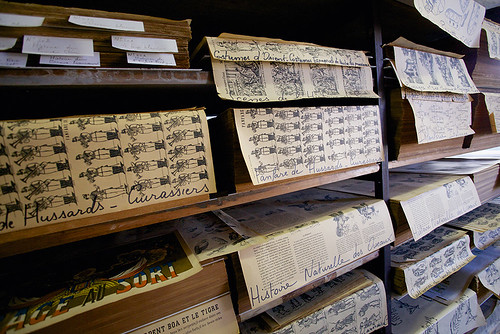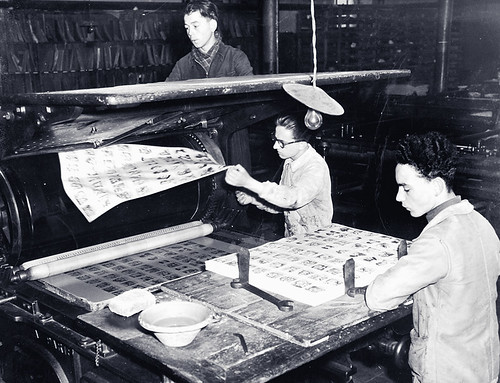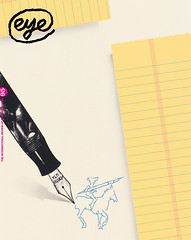Winter 2017
Hidden treasure
Two hours from Paris, the historic printing house Imagerie d’Épinal is reborn as the heart of a contemporary French brand
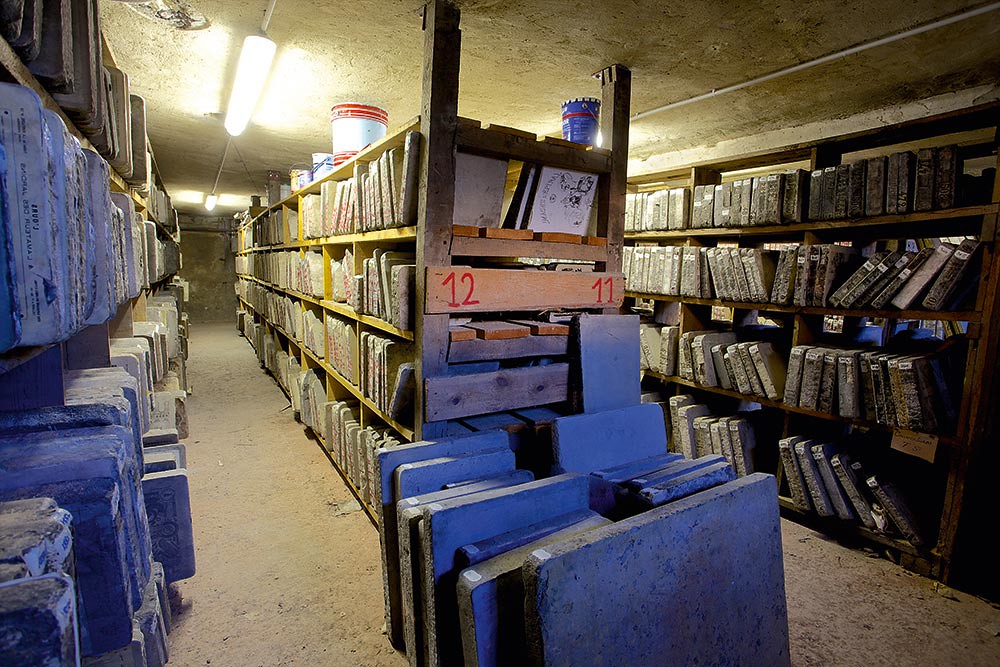
The original Images d’Épinal were the once ubiquitous ‘penny prints’ made in Épinal, a town in the Vosges region of northeastern France. Printed in black and white or in vivid colour, the prints depicted Napoleonic triumphs, children’s storybook scenes, saints, biblical tableaux and coloured cut-outs that can be assembled to make models of stages, buildings, soldiers and jumping jacks. They were the mass media of their time, eagerly acquired for their exotic subject matter and lurid colours. They were sold in shops and on street corners.
For a long while, the images were a source of national pride, and Épinal became known as the Capital de L’Imagerie. The term ‘image d’Épinal’ became a figure of speech for an optimistic view of a subject, similar to the English phrase ‘to look at the world through rose-tinted spectacles.’
The printing house dates back to 1796, when Jean-Charles Pellerin started the business. Though the twentieth century was not kind to the company, the building that houses the cavernous, largely empty print works and its vast archive is still standing. Its endurance is thanks to a series of stubborn owners and the support of the town, but the business has been perilously close to bankruptcy several times.
Nineteenth-century lithographic print of Russian infantrymen made by the Pellerin company in Épinal. Many of the Imagerie’s most popular prints were illustrated taxonomies of items from history, fashion and the natural world.
Top: To walk into the extensive underground cellars at Imagerie d’Épinal in northeastern France is to enter an Aladdin’s cave of printing history. The shelves of the huge storage space are stacked with heavy lithographic stones.
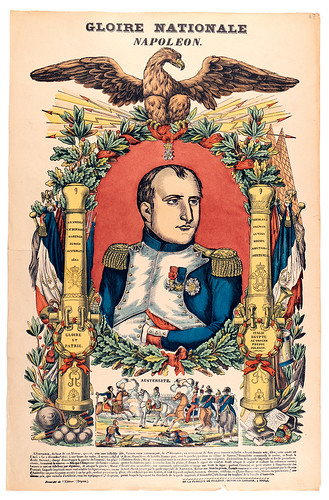
In 2014, when the business once more faced such a threat, two Parisian entrepreneurs – Christine Lorimy and Pacôme Vexlard – came to Épinal and, much to everyone’s surprise, bought the whole operation. Now, three years on, they have coaxed the business into something new. Though the company Imagerie d’Épinal (a slight variation on the original name of Images d’Épinal) is still based upon that huge treasury of images, Lorimy and Vexlard, with the help of creative director Philippe Andrevon, have been commissioning a large number of contemporary illustrators. The new work bears the Imagerie d’Épinal name, and retains something of the naïve, colourful spirit of the original prints.
The new team began by making all manner of products, including prints, books and stationery, and gifts such as mugs, T-shirts, paperweights, tote bags and fridge magnets. Last year (2017) Lorimy and Vexlard started a new venture: Maison Images d’Épinal. This home decor business includes table mats and cushion covers, which means you can decorate your Left Bank apartment with an enormous detail of the Tour d’Eiffel, or some flora and fauna.
Prints from several eras of the Imagerie’s existence are piled up in storerooms in Épinal. These luridly colourful ‘Petites Constructions’, which could be cut out and glued together to make models of Siamese Palaces, farmhouses, jumping jacks and so on, were low-cost toys and amusements that families could make themselves.
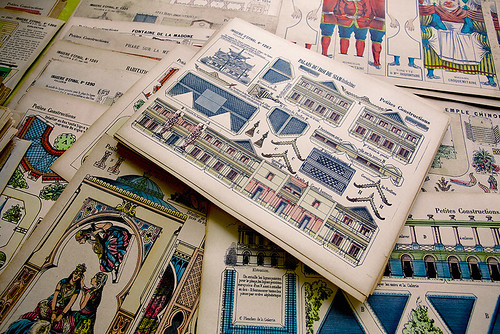
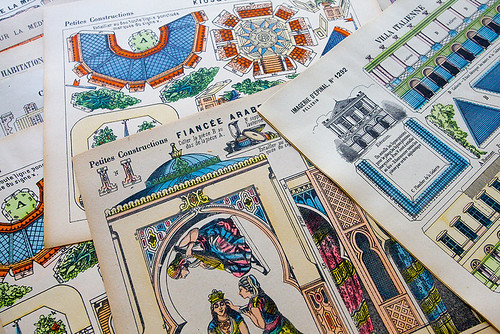
From the start, the main ambition of Lorimy and Vexlard has been to turn Imagerie d’Épinal into a thoroughly 21st century business – making new things under the aegis of this famous ‘heritage brand’. At the same time they also inherited the responsibility of managing the print works and its eight full time employees (plus more freelancers), making use of the sprawling site for workshops, events, student workshops and tourist visits, and negotiating a sometimes sensitive relationship with the local community. There is a gift shop that sells new prints and recycles old ones from the shelves of its vast archives, which are stacked high with piles of prints and uncut pages from more than two centuries of productive life.
Students and amateurs still come to the building for workshops and special events. Lorimy says that students are fascinated by the lithographic printing and pochoir colouring, while casual visitors are always amazed by the Aquatype machine.
A ‘horned’ (or ‘star-wheel’) hand press for making lithographs at Imagerie d’Épinal.
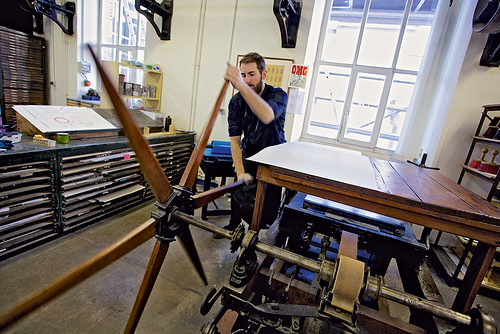
This reinvention is a big project to take on. Simon Esterson and I first encountered Lorimy at Imagerie d’Épinal’s Parisian pop-up store in November 2015. The temporary shop site had lithographic stones in the window, plus posters, cards and other printed items for sale, some of them clearly from the company’s nineteenth-century heyday, and Lorimy told us a little about the huge undertaking, and the Épinal print works. The following January, photographer Philip Sayer and I set off for Épinal so that we could see it for ourselves.
One of the many lithographic stones in the vaults. The limestone for the stones came from a quarry in Austria.

The print works is a vast building on the edge of town. Lorimy’s small office is tucked away in one corner, but the main spaces offer ramshackle evidence of the history of printing – part museum, part working press rooms, with areas dedicated to letterpress, silkscreen, litho printing and the clanking, nine-colour Aquatype machine, with its stencils and enormous brushes. Printer David Allart operated the machine, sitting on a seat fixed to one end of the contraption like a boating cox. In a corner of the room sat a couple of neglected Linotype machines, plus a display board showing the Aquatype engineering diagrams and sales brochures. Near the entrance, an old, enamelled wayfinding sign to Images d’Épinal shows a vendor in a wide-brimmed hat with a basket of prints on his back, showing samples to a couple of young boys.
Lithographic stone and print (kept with the stone for easy identification) showing illustrations of anthropomorphised wild animals, accompanied by whimsical verse. By Édouard Gabriel Gostiaux, aka Phosty (1838-1910).

In an adjacent space, a bigger but even more empty room, Allart showed us the litho press (which he described as a temperamental ‘horned machine’) with its strong straps, which he operates by hand. He had been using aluminium plates on a stone base to make four-colour prints, which were drying in racks nearby. The presses were originally driven by a system of rods and pulleys (some of which can be seen in the main print room), all connected to a massive steam engine in a different part of the building. There is also a screenprinting area, still in use with drying racks, and a little-used letterpress section packed with cases of metal type.
Christine Lorimy, co-owner (with Pacôme Vexlard) of Imagerie d’Épinal since 2014, holds up La France, t’es où? a contemporary print by Jochen Gerner, who drove from Nancy to supervise and sign his litho prints in the main room.

From here we were led to the ‘museum’ part of the building, with an old metal Images d’Épinal sign on a pillar, plus display cases of type, with captions from earlier decades. You half expect the ghosts of printers past to rush past you on the stairs. The upper rooms have odd prints on the walls, stones, unused machinery and other detritus of the printing trade. But the most dramatic vista comes when you climb down into the extensive cellars, which are full of lithographic stones.
Lithography, whose invention dates from the end of the eighteenth century, is a chemical method of transferring ink onto paper from a specially prepared limestone surface – the stone. Chromolithography, developed a little later, applied the same principles to colour images. In Épinal, these huge objects have been filed away in rows of sturdy shelving, as if still awaiting orders for reprints, and the Imagerie d’Épinal staff and visitors still use them regularly. Lorimy describes the stones as a ‘permanent source of inspiration for new productions’.
A wide view of the main print room at Imagerie d’Épinal, with type cases for letterpress printing, two ‘horned’ lithographic presses and screenprinting equipment at the far end. Brackets, rods and pulleys, the remains of a system that drove the original steam-powered lithographic presses, can be seen overhead. In the foreground, a lithographer damps the stone with a sponge before charging it with ink from the roller on the inking slab just behind him.
The stockrooms are packed with prints, posters and unbound pages for illustrated books in several languages.
Philip Sayer’s photo shows David Allart operating the Aquatype automated stencilling machine. Imagerie d’Epinal houses the last two machines in the world. On the bed of the machine are the stencils for Simon Bailly’s L’Exil sur Sainte-Hélène.

During our few days there, graphic artist Jochen Gerner was in attendance, signing a limited edition of four-colour litho prints, and there was a visit from Étienne Thery, the director of the Épinal campus of ESAL (École supérieure d’art de Lorraine). ESAL works each year on educational projects with half a dozen selected students and Imagerie d’Épinal is now aiming to create a year of study in the workshop for a joint Masters course with the college.
A stone’s throw from Imagerie d’Épinal, on a plot of land right in front of the print works, is Épinal’s Museum of the Image (est. 2003). This public museum, which celebrates the town’s long association with printing, holds a permanent collection of work from the Vosges municipal collection – more than 110,000 images from France and abroad – and mounts temporary exhibitions on related subjects.
The Aquatype’s mechanised brushes.

Vexlard and Lorimy, whose backgrounds are in digital marketing and web design, are not the most likely custodians of such arcane premises, though Lorimy’s grandfather was from the Vosges region. After stints with La Poste and e-commerce company vente-privee.com, she became a consultant, in which capacity she first encountered Imagerie d’Épinal and Eric Staub, a local businessman who had been chairman and managing director of Imagerie d’Épinal since the 1980s.
Though Staub was considering selling the Imagerie d’Épinal brand to a German company, he was impressed by Lorimy and Vexlard, and suggested they buy the company instead, declaring that, ‘We can’t sell to strangers!’
Aquatype detail – the print can be glimpsed through the green stencil for Bailly’s Exil print.
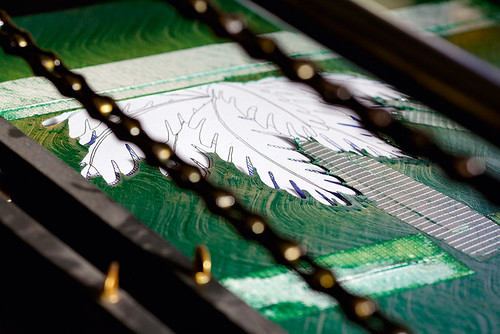
On their way back to Paris from Épinal, Lorimy and Vexlard made a long list of pros and cons. There was only one pro: ‘It’s a fucking brand!’ To their way of thinking, the chance to buy a genuine brand name – one that means something to every French and French-speaking person – was a once-in-a-lifetime opportunity. Furthermore, there was the emotional tug of a vulnerable entity that needed rescuing: ‘We couldn’t let this company die,’ said Lorimy.
The economics of the company are convoluted, and depend upon a small, hardworking staff, a pool of enthusiastic volunteers and students, and good relations with the local mayor, who charges them a peppercorn rent and makes sure the listed [édificies inscrits] building is maintained. The founders’ small team is now augmented by a marketing manager and a commercial director. They travel the world to promote the company, making research trips to Japan, South Korea, Australia, Dubai and the US. Their prospective customers are no longer just the local nostalgists and hipsters who buy Serge Bloch tote bags, Laurent Blachier mugs and Salch T-shirts, but now – with Maison Images d’Épinal – architects, interior decorators and their wealthy clients throughout the world.
Allart adds ink to the Aquatype by hand.

Lorimy is always bursting with ideas to make something new out of the company she’s acquired – a mural at Art Basel Miami, a pop-up shop in London, collaborations with international artists. It takes a just a few minutes in her company to become caught up by her enthusiasm. But the challenges she and Vexlard face are considerable. Maybe it is appropriate that the future of the project requires immense optimism – an ability to see the future through rose-tinted glasses – an archetypal Image d’Épinal.
The house that Pellerin built
The Vosges area has been known for its image-makers and printers for centuries. Jean-Charles Pellerin founded the company now known as Imagerie d’Épinal when he inherited his family’s image-making business. At first, he made playing cards and other coloured papers using woodblocks for black outlines and text, with cardboard stencils for the colouring. This tradition had endured for more than two centuries, but the powerful printers’ guild had banned the more ‘lowly’ image-makers from owning presses and movable type. However the guild’s power was weakened in the wake of the French Revolution in 1789.
By 1810, Pellerin had acquired a printer’s licence and installed three hand presses for type, soon followed by a stéréotype foundry (for casting metal plates) that enabled him to print type and image together with greater efficiency. Pellerin’s son Nicolas took over the business in 1822 and expanded further, printing books and averaging 420,000 images a year over the next two decades.
This archive photograph, taken around the time of the company’s centenary in 1896, shows a worker using a brush to apply watercolour by hand through a stencil (pochoir) on to a black and white print.

Charles Pellerin, son of Nicolas, took charge of the company in 1854, and slowly replaced the stéréotypes with lithography, which he had studied as an apprentice in Paris. Chromo-lithography arrived in 1882, and was used for better quality colour images alongside the cheap stencil-colouring for which the printer was known.
In 1898 Pellerin moved his firm to its present premises, and in 1902 installed two Aquatype machines, with their enamelled tin stencils, whose brushes could apply up to nine colours at the rate of 500 images an hour.
Épinal in the 1930s, printing directly from a large lithographic stone on the bed of a cylinder machine. This is operated by three people: one feeds the press, another takes the sheet from the machine with the help of a device called a ‘flyer’, and the third appears to be making sure that the sheets are stacked neatly. On the board in the foreground are a sponge and a bowl of water for damping the rollers. The stone and sheets show four pages to view. Most Épinal prints include 16 to 24 small images to the sheet: picture stories, or a set of images related by theme.
Automated pochoir – the Aquatype shown soon after its installation, 1902.

A catalogue from 1904 listed 9000 different images for sale, from prints to picturebooks, made from stencils, woodcuts and lithography. The company continued in the twentieth century, still associated with leading names in illustration and comic books.
However, by 1984, declining sales took the company close to bankruptcy and it was rescued by a consortium of local shareholders, who kept it going for the next 30 years.
Old methods, new artists
Soon after they acquired Imagerie d’Épinal, Christine Lorimy and Pacôme Vexlard hired Philippe Andrevon to oversee a programme of fresh commissions. The list – now more than 40 – is a mix of newcomers and big names, including Serge Bloch, Paul Cox, Tomi Ungerer, Jean Jullien, Zoé Thouron, Hélène Humbert and French-Colombian artist Chanoir, whose bug-eyed graffiti paintings decorate one of the staircases.
Nineteenth-century lithographic print of Russian infantrymen made by the Pellerin company in Épinal. Many of the Imagerie’s most popular prints were illustrated taxonomies of items from history, fashion and the natural world.

Recent additions to the roster include film director / illustrator Charlie Poppins, the highly commercial Clara Mari, celebrated bande dessinée artist Emmanuel Guibert, Salch and Simon Bailly, an ESAL graduate. Also responsible for comic-book-style posters are Belgian cartoonist François Schuiten, François Bourgeon and the late Fred (Frédéric Othon Théodore Aristidès, 1931-2013).
Simon Bailly’s contemporary L’Exil sur Sainte-Hélène shows a disgruntled Napoleon, marooned on his not-so-idyllic island.

Andrevon (formerly Vexlard’s boss at a web design company) gives the artists strong guidelines. Each print should tell a story, or show a thematic collection – using one of the old prints as a starting point – and display the title in the same, long-established place on the page. Peter Allen, a British-born illustrator who now lives near Épinal, has described (in Matrix 13) the imagiers’ strength as their ability to ‘distil the essential features of an event, of a person, to form a stylised representation’. Pictures in the Imagerie d’Épinal archive, from heroic battles and generals to fantastical animals, demonstrate this approach over the decades. Contemporary equivalents of these images, such as Jochen Gerner’s La France, t’es où?, Chloé Begey’s cut-out dioramas and Zoé Thouron’s comic animals, reflect the same impulse.
Wall covering and cushion cover from Maison Images d'Epinal (MIE), the company set up by Lorimy and Vexlard to market Imagerie d'Épinal’s pictures as interior décor worldwide. Items in MIE’s catalogue draw on the Imagerie’s treasure trove of colourful images from the past two centuries.
Tipping her hat to Épinal’s traditions, illustrator Zoé Thouron, who studied locally at ESAL (École supérieure d’art de Lorraine), contributes Les animaux de la ferme, a 2015 taxonomy of farm animals drawn from a novel perspective.

Whatever the style or medium, Lorimy insists there should always be a clear connection to Imagerie d’Épinal’s print tradition in format and content. Bailly’s L’Exil sur Sainte-Hélène, a colourful Napoleonic stencil print on the bed of the Aquatype machine at the time of our visit, supplied a vivid demonstration of this.
John L. Walters, editor of Eye, London
First published in Eye no. 95 vol. 24, 2018
Eye is the world’s most beautiful and collectable graphic design journal, published for professional designers, students and anyone interested in critical, informed writing about graphic design and visual culture. It is available from all good design bookshops and online at the Eye shop, where you can buy subscriptions and single issues. You can see what Eye 95 looks like at Eye Before You Buy on Vimeo.


